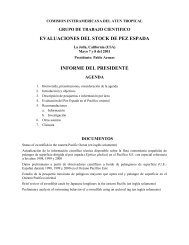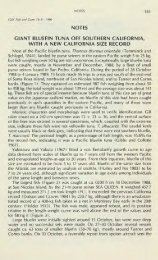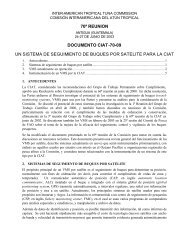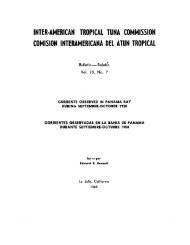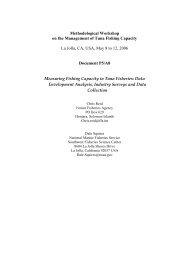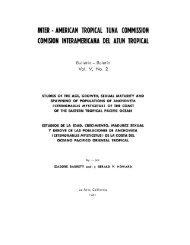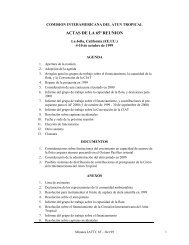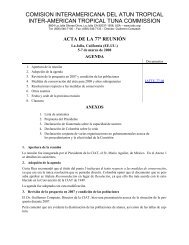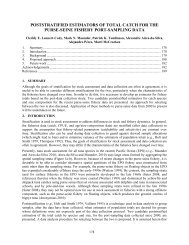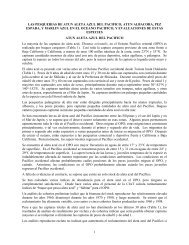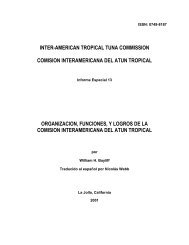Informe Anual de la Comisión Interamericana del Atún Tropical, 19
Informe Anual de la Comisión Interamericana del Atún Tropical, 19
Informe Anual de la Comisión Interamericana del Atún Tropical, 19
You also want an ePaper? Increase the reach of your titles
YUMPU automatically turns print PDFs into web optimized ePapers that Google loves.
30 TUNA COMMISSION<br />
feet) below the normal <strong>de</strong>pth for the equatorial area between 2°8 and 5°N, east of 130'W, and also<br />
along the coast ofEcuador (personal communications from D. W. Behringer, At<strong>la</strong>ntic Oceanographic<br />
and Meteorological Laboratory, V.S. National Oceanographic and Atmospheric Administration,<br />
Miami, Florida).<br />
In July <strong>19</strong>86, before the thermocline began to <strong>de</strong>epen, the sea level started to rise. In Figure<br />
24A are shown data on the sea-leve! anomalies (<strong>de</strong>partures from the normal mean sea level) based on<br />
data averaged for three coastal stations from Colombia to northern Peru. Mter June <strong>19</strong>86 the sea<br />
level along the west coast of South America remained aboye normal except for a brief interval in<br />
December <strong>19</strong>86 when it was slightly below normal. By February <strong>19</strong>87 the sea level had risen to 10 cm<br />
(4 inches) aboye normal. Thereafter, it slowly lowered, reaching normal by the end of<strong>19</strong>87. In May<br />
<strong>19</strong>87, 3 months after the sea level reached its maximum, the S8Ts reached their peak of 3°C aboye<br />
normal, and then leveled offat about 1° to 2°C aboye normal through the end ofthe year (Figure 24A).<br />
As an El Niño <strong>de</strong>velops there is a <strong>de</strong>crease in the strength of the easterly tra<strong>de</strong> winds across<br />
the South Pacific, especially offthe coast ofSouthAmerica south of15°S. This results in weaker-thannormal<br />
wind mixing, which is nee<strong>de</strong>d to maintain strong upwelling in the coastal part of the Peru<br />
Current. Aweakening ofthe wind circu<strong>la</strong>tion in the South Pacific is re<strong>la</strong>ted to <strong>la</strong>rge-scale changes in<br />
the atmospheric circu<strong>la</strong>tions which are usually represented by the Southern Oscil<strong>la</strong>tion In<strong>de</strong>x (SOl),<br />
indicated as a difference in sea-level pressures between Darwin, Australia, and an average ofEaster<br />
Is<strong>la</strong>nd and Tahiti. The differences for individual years or months are compared to long-term mean<br />
pressure differences to calcu<strong>la</strong>te anomalies ofthe SOr. Negative anomalies represent weaker-thannormal<br />
surface winds and lower surface pressures in the ETP south of the equator, and positive<br />
anomalies represent the reverse. Data on the variations in the SOl for <strong>19</strong>86 and <strong>19</strong>87 are given in<br />
Figure 24B. During most of<strong>19</strong>86 the SOl oscil<strong>la</strong>ted about the zero line, but after October it became<br />
negative and remained so until November <strong>19</strong>87. Thus by the end of<strong>19</strong>87 the lowering ofthe sea level<br />
along the coast ofSouth America and the trend ofthe SOl to move back toward normal suggested the<br />
El Niño was weakening in the ETP. However, the 88Ts were still aboye normal and the thermocline<br />
remained <strong>de</strong>eper than normal (Figure 23). This indicates that residual effects of the El Niño will<br />
remain through the austral summer of <strong>19</strong>87-<strong>19</strong>88.<br />
This El Niño is not expected to regenerate after the end ofthe austral summer of<strong>19</strong>87-<strong>19</strong>88.<br />
El Niño and low catch rates<br />
Significant El Niño events occur in the ETP every 4 to 6years, on an average. The intensity<br />
and extent of these events differ markedly, however. Tunas apparently react to El Niño events by<br />
moving away from the area or <strong>de</strong>eper into the mixed <strong>la</strong>yer, possibly in search of food, and thereby<br />
become less avai<strong>la</strong>bJe or vulnerable to capture by purse seiners.<br />
The El Niño of<strong>19</strong>86-<strong>19</strong>87, <strong>de</strong>scrihed in the previous section, was ofmo<strong>de</strong>rate intensity, hut its<br />
effect on the ocean environment in the ETP was not wi<strong>de</strong>spread. It was restricted during most of<br />
<strong>19</strong>86-<strong>19</strong>87 to the ETP south of 5°N, where the catches per unit of effort (CPUEs) were very poor<br />
during <strong>19</strong>86 and <strong>19</strong>87, especially in the coastal area off Ecuador and northern Peru. In contrast,<br />
fishing was quite successful during those two years in the ETP north of 5°N, where the effects ofthe<br />
El Niño appear to have been minimal. One ofthe regions most often affected by El Niño events is the<br />
heavily-fished area outsi<strong>de</strong> the Gulf of Guayaquil, boun<strong>de</strong>d by the equator, 5 0<br />
S, 85°W, and the coasts<br />
of Ecuador and Peru. During <strong>19</strong>86 and <strong>19</strong>87 the catches of skipjack and yellowfin were generally<br />
below the mean annual catch for the same area between <strong>19</strong>65 and <strong>19</strong>84. (It should he pointed out,<br />
however, that there has been a downward trend in the catches ofthese two species during the <strong>19</strong>61<br />
<strong>19</strong>84 period.)<br />
Data on the fishing effort and CPUEs for skipjack and yellowfin for <strong>19</strong>86 and <strong>19</strong>87 and for<br />
<strong>19</strong>65-<strong>19</strong>84 for the 5-<strong>de</strong>gree area <strong>de</strong>scribed aboye are presented in Figure 25. Throughout <strong>19</strong>86 the<br />
fishing effort (Figure 25A) was less than the <strong>19</strong>65-<strong>19</strong>84 mean. In <strong>19</strong>87 the fishing effort was below the



